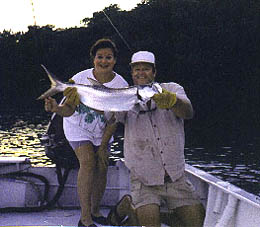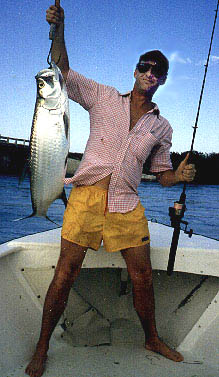 Part of the
Part of theFISHING THE FLORIDA KEYS
Series
Florida Tarpon Fishing
 Part of the
Part of the
FISHING THE FLORIDA KEYS
Series
Good things come in small packages; those feisty
juvenile tarpon can put a smile on the face of any angler.
 During the springtime months of April, May, and June, everybody
who's anybody in the realm of Florida Keys sportfishing is on the water chasing their
favorite gamefish. Some spend their days in pursuit of giant tarpon. Others
prefer the challenge of stalking those elusive bonefish and permit in skinny water.
And there are those who take their aspirations offshore, hunting for dolphin, wahoo, and
maybe a crack at the grand daddy of them all, the blue marlin. Plenty can be said
about each of these fish, and this writer knows better than to claim that one species is
more popular than the rest.
During the springtime months of April, May, and June, everybody
who's anybody in the realm of Florida Keys sportfishing is on the water chasing their
favorite gamefish. Some spend their days in pursuit of giant tarpon. Others
prefer the challenge of stalking those elusive bonefish and permit in skinny water.
And there are those who take their aspirations offshore, hunting for dolphin, wahoo, and
maybe a crack at the grand daddy of them all, the blue marlin. Plenty can be said
about each of these fish, and this writer knows better than to claim that one species is
more popular than the rest.
But there is a particular fish that is near and dear to the hearts of light-tackle anglers
throughout the Keys. This fish will never be described with glowing terms such as
awesome, incredible, or magnificent. Their strike is far from heart stopping, and
their runs fall far short of line sizzling. To top it off, you can't even eat the
things.
What this fish does amount to though, is the friskiest, jumpingest, light-tackle fish an
angler could ever want. We're talking baby tarpon here, and with large tarpon having
earned the name Silver King, it certainly would not be overstatement to bequeath the title
of Silver Prince upon their younger brethren.
How Big is Small?
Although there are no universal parameters
that define what a baby or juvenile tarpon actually is, it's generally agreed that any
tarpon under 15 pounds qualifies (though a typical size is more like 5 to 10
pounds). These fish possess an uncanny ability to put a smile on the face of even
the most experienced angler. What a contrast it is to see a veteran fly fishermen
(who normally wears his "game face" while fighting larger tarpon) break into a
ear to ear grin while playing out one of the little guys on light gear. In a
nutshell, baby tarpon are pure, unadulterated fun!
While it's not necessary to build a case for the experience of hooking and landing giant
tarpon, there are some distinct advantages in targeting their younger brethren.
First, they're easy on the body. There's no epic two hour struggle in landing these
fish. In fact, seldom more than a few minutes elapses from hookup to release.
Secondly, the tackle is a lot lighter, with 8 pound spinning tackle or an 8 weight fly rod
(a 7 weight is even better if wind is not an issue) being about right. One final plus is
this: When it's late in the day and I'm sitting on two legs of a grand slam (needing only
a tarpon to round it out), I'll frequently turn to baby tarpon as the easiest way to put
it together.
Yes, but How?
There are several ways to go about
targeting these fish. Perhaps the most popular is to look for them out in the
backcountry along the edges of mangrove shorelines. It is really exciting to pole in
toward a treeline shortly after dawn and find a pod of undisturbed baby tarpon rolling and
feeding. A live shrimp reeled slowly just under the surface along the perimeter of
this activity is an automatic strike at times like this. A small fly (marabou collar
and a grizzly hackle wing...I prefer natural looking rather than colorful tarpon flies)
tied on a #1 hook should also enjoy the same results, though you'll want to work that fly
faster than you might think (rapid, foot-long strips). When the tarpon strikes,
avoid the tendency to employ a "career hookset"... just come tight on him by
lifting the rod and he should be there. I instruct my anglers to bow to a jumping
fish just like they would a large tarpon, the idea being not so much for fear that these
little guys are going to land on the leader and break it, but rather because the small
hooks I use will often tear out under pressure during one of those patented head-shaking
leaps for which baby tarpon are famous.
 About the only real
problem one might encounter while fighting a fish here (other than the tarpon jumping into
an over-hanging limb and snapping the line), is that tarpon will occasionally try to make
a power run back to the safety of the overhanging branches and root systems of the
shoreline. It's important to turn the fish before he gets there; adding a
little extra pressure with the hand on the rim of the spool to increase the effective drag
should stop the fish. The trick here is to "feather" the spool rather than
clamp down on it, thereby risking a breakoff. If the tarpon does make it into the
mangroves, then clamp the spool with your hand, bury the rod tip in the water (to clear
the overhanging branches) and try to drag him out of there. Tarpon won't dive deep
into a root system like a snook will; you might be surprised how often you can muscle one
out of the roots.
About the only real
problem one might encounter while fighting a fish here (other than the tarpon jumping into
an over-hanging limb and snapping the line), is that tarpon will occasionally try to make
a power run back to the safety of the overhanging branches and root systems of the
shoreline. It's important to turn the fish before he gets there; adding a
little extra pressure with the hand on the rim of the spool to increase the effective drag
should stop the fish. The trick here is to "feather" the spool rather than
clamp down on it, thereby risking a breakoff. If the tarpon does make it into the
mangroves, then clamp the spool with your hand, bury the rod tip in the water (to clear
the overhanging branches) and try to drag him out of there. Tarpon won't dive deep
into a root system like a snook will; you might be surprised how often you can muscle one
out of the roots.
Other
Hangouts
It's also possible to find these fish out
in the open on a flat, either "layed up" or else slowly working along the edge
of the flat. Although one would think these fish should be easier to work than those
along the mangroves, the lack of cover can make them extra spooky. Obviously, a
quiet approach with a push pole is necessary.
Another area where juvenile tarpon can be found is around the bridges throughout the Keys.
Like their larger brethren, baby tarpon find the bridges to be a handy location
from which to ambush bait that is being swept through with the tide. I've had my
best results fishing the ends of the bridges close to the shoreline; the smaller fish just
seem to be more comfortable about feeding here. Because of the close proximity of
all of that nasty concrete, I prefer to use a little heavier line to fish with...12 pound
is about right. I like to fish up current of the bridges, and drift my baits (live
shrimp, small pinfish, or finger mullet) back to the fish. Working a fly cross
current uptide of the bridge can also be productive. This is an especially effective
technique at night.
Also effective at night is targeting baby tarpon around lighted docks. Again, a live
shrimp is hard to beat, but be sure to make your casts out along the outer perimeter of
the lighted area on the water.
Easy
Does It
Since tarpon are of no food value, a word needs to be said here regarding proper release
techniques. I've watched people really beat the hell out of a baby tarpon in the name of
catch and release. These fish are at a very vulnerable stage in their life, and
don't take well to being dropped on the deck of a boat or bounced off the edge of a dock.
The best way to release these feisty battlers is to unhook them in the water.
With a gloved hand, grasp the tarpon firmly by the bottom jaw. Unhook the
fish with the other hand, using long nose pliers or a dehooker if the hook is deep in the
roof of the mouth. Should you gut hook a fish, don't try removing the hook, as you'll
probably do more damage than good. Simply cut the line as close to the hook as
possible...and next time don't let him eat for so long!
One study I've read states that a 70 pound tarpon is about 17 years old. This means
there's a pretty good chance a large fish can get caught a number of times during its
life. So be gentle on the little guys...a little extra care now will go a long way
in protecting what is a very sustainable fishery.
Looking for a fish that is a light-tackle fisherman's dream, as well as a great
alternative to some of the other highly sought species of springtime? Look no
more...the Silver Prince awaits you.
Site last updated 9/8/99
![]()
 ABOUT THE AUTHOR Captain Buddy LaPointe, has over 20 years of
experience charter fishing in the Florida Keys. A cum laude graduate of Pensacola
Christian College, Captain Buddy is professional, courteous, and dedicated to showing his
clients a great time on the water! Captain LaPointe has been featured in the Miami
Herald, and on Mark Sosin's Saltwater Journal, (seen weekly on national
television). In addition, Capt. Buddy has written numerous articles for Sport Fishing
Magazine, Saltwater Sportsman, Fishing the Florida Keys and the Florida
Keys Keynoter.
ABOUT THE AUTHOR Captain Buddy LaPointe, has over 20 years of
experience charter fishing in the Florida Keys. A cum laude graduate of Pensacola
Christian College, Captain Buddy is professional, courteous, and dedicated to showing his
clients a great time on the water! Captain LaPointe has been featured in the Miami
Herald, and on Mark Sosin's Saltwater Journal, (seen weekly on national
television). In addition, Capt. Buddy has written numerous articles for Sport Fishing
Magazine, Saltwater Sportsman, Fishing the Florida Keys and the Florida
Keys Keynoter.
![]()
|
HOMEPAGE | ARTICLES | EMAIL/FEEDBACK |